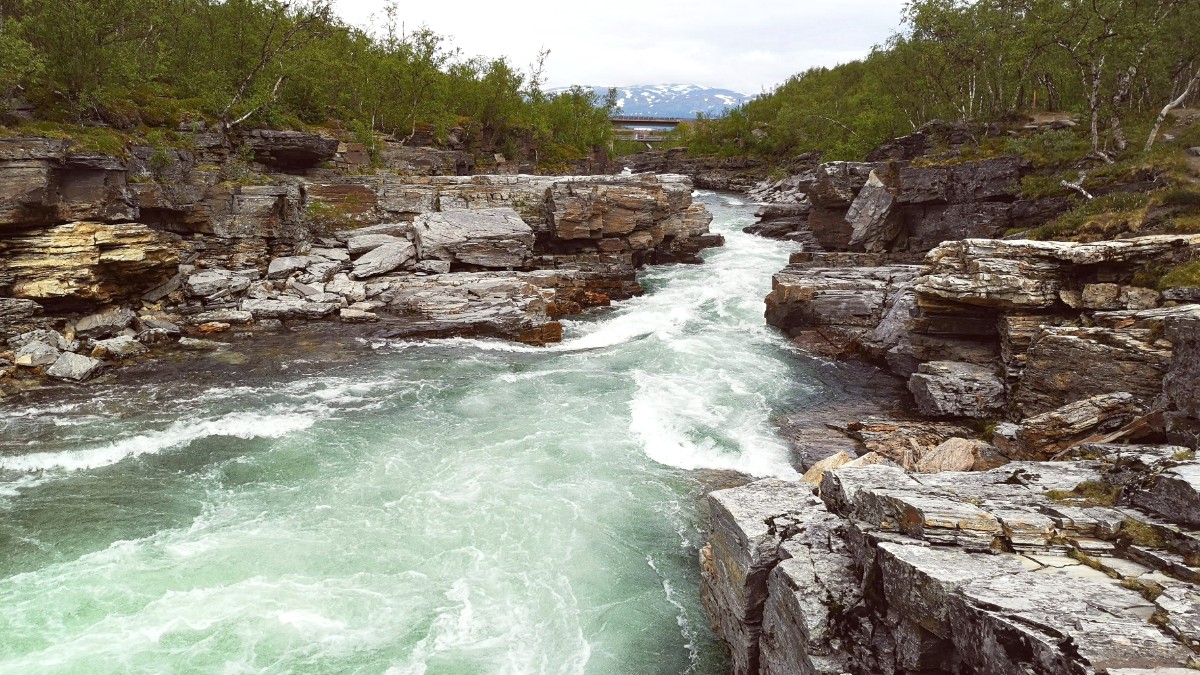
Norrland, Sweden
Abisko holds several instantly recognizable natural landmarks. Abisko National Park, established in 1909, ranks among Sweden's oldest national parks. Its main purpose includes scientific research and the preservation of the subarctic mountain and birch forest areas. The park shelters unique flora and fauna adapted to the Arctic climate. Its expansive landscapes present serene beauty. Entry remains free, and the park is open year-round.
Lapporten (The Lapponian Gate), a distinctive U-shaped valley formed by glaciers, lies between two mountains, Tjuonavagge and Nissunvárri. It serves as a natural landmark and a symbol of Lapland. Lake Torneträsk, one of Sweden's largest and deepest lakes, forms part of the park's northern boundary. The lake stays mostly ice-covered in winter, creating a vast, white expanse. In summer, its deep blue waters mirror the sky.
Booking in advance is highly recommended, especially for evening sessions.
The main visitor center for Abisko National Park. It features exhibitions about the park's natural history, geology, wildlife, and the Sami culture in the region.
It also presents practical information on hiking trails and park regulations.
Open seasonally. Check the STF website for current hours.
Entry is free.
Naturum Abisko occasionally hosts talks or events related to the park's environment or research. Inquire upon arrival.
Abisko's history deeply connects to its natural landscape and the growth of Arctic infrastructure. No prominent archaeological sites or ruins exist directly within Abisko National Park.
This railway passes directly through Abisko and represents a significant piece of industrial heritage.
It proved for transporting iron ore from Kiruna and Gällivare to the Norwegian port of Narvik.
This railway permitted the development of northern Sweden.
The buildings themselves portray early 20th-century tourist infrastructure in the Arctic.
They present a glimpse into the pioneering days of Arctic tourism.
None specific to Abisko exist.
Abisko offers limited traditional museum experiences, concentrating on its natural heritage through Naturum Abisko.
Art galleries and performance venues are limited to small displays within Naturum. Cultural experiences generally center on Sami culture tours (often from Kiruna) or direct interaction with nature.
Naturum Abisko occasionally hosts talks or events related to the park's environment or research. Inquire upon arrival for potential special programming.
Abisko excels in its natural beauty, offering pristine subarctic wilderness and striking geological features.
Abisko National Park presents a pristine subarctic wilderness, protected for its unique nature and scientific value. It features the Abiskojåkka river, Abisko Canyon, and diverse ecosystems. Mount Njullá, accessible by chairlift, offers panoramic views of Lapporten, Lake Torneträsk, and surrounding mountains. In summer, Njullá is known for its rich flora.
The region exhibits classic U-shaped valleys (like Lapporten), glacial cirques, and a rich geological history shaped by ice ages. The Abisko Canyon powerfully showcases the river's erosive power over ancient rock.
Seek out some lesser-known spots for a more singular experience.
Capture memorable images of Abisko's striking landscapes.
While not "emerging" within Abisko itself, combining a visit with a trip to nearby destinations offers diverse experiences.
These additions broaden your Arctic adventure, presenting coastal views or alpine skiing opportunities.
A short train ride away, Narvik offers coastal scenery, a deep-water port, and World War II history.
Situated on the Swedish-Norwegian border, this ski resort is known for its late-season skiing and unique Arctic alpine environment.
Sweden's northernmost city, famous for its iron ore mine and ongoing city relocation project. A good base for Sami cultural tours.
Book tickets for local attractions and experiences through reliable platforms to secure your spot.
Explore options on GetYourGuideFor broader Northern Sweden and Arctic Norway travel information, consult official tourism boards and travel guides.
Visit Swedish Lapland websiteThe scenic train ride on the Malmbanan from Kiruna or Narvik offers stunning views of the Arctic landscape.
Book train tickets via SJ (Swedish Railways)Ensure you have appropriate gear for the Arctic climate, especially for outdoor activities and aurora viewing.
Fjällräven (Swedish outdoor brand)Integrate visits to attractions with your chosen activities to craft a cohesive itinerary.
Arctic weather can change rapidly. Stay informed about conditions for safe and enjoyable sightseeing.
The "blue hole" microclimate of Abisko is a local phenomenon that frequently results in clear skies.
This microclimate creates favorable conditions for Northern Lights viewing, making Abisko a prime destination.
Beyond the iconic views, Abisko presents numerous chances for captivating photography. When capturing the beauty of Abisko, remember to respect its pristine environment.
Abisko National Park holds protected status. Your adherence to park rules preserves its natural beauty.
Familiarize yourself with Abisko National Park's specific rules to ensure a respectful visit.
The Naturum Abisko provides full details on park regulations.
The Sami people hold a deep connection to this land. Show respect for their culture and way of life.
Avoid commercial ventures that may exploit cultural heritage.
Abisko's wilderness presents both beauty and challenges. Prioritize safety during your explorations.
Weather conditions change rapidly; dress appropriately and be ready to turn back.
Accessible by chairlift. The station intends to accommodate visitors, but severe weather can affect operation.
A range of trails exists, from easy, paved paths around Turiststation to challenging backcountry routes. Accessibility varies by trail.
Generally accessible. Check directly for specific accessibility features if needed.